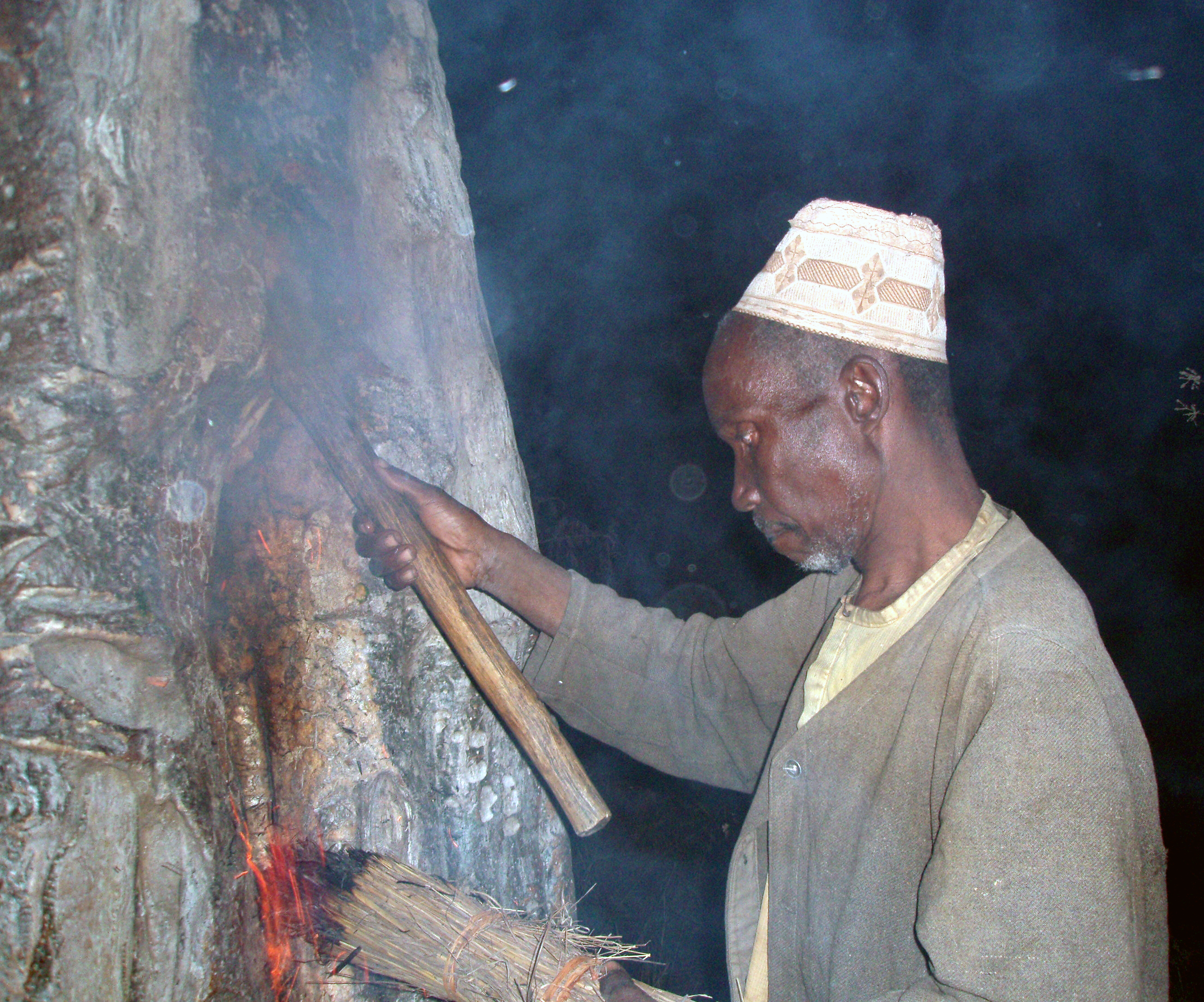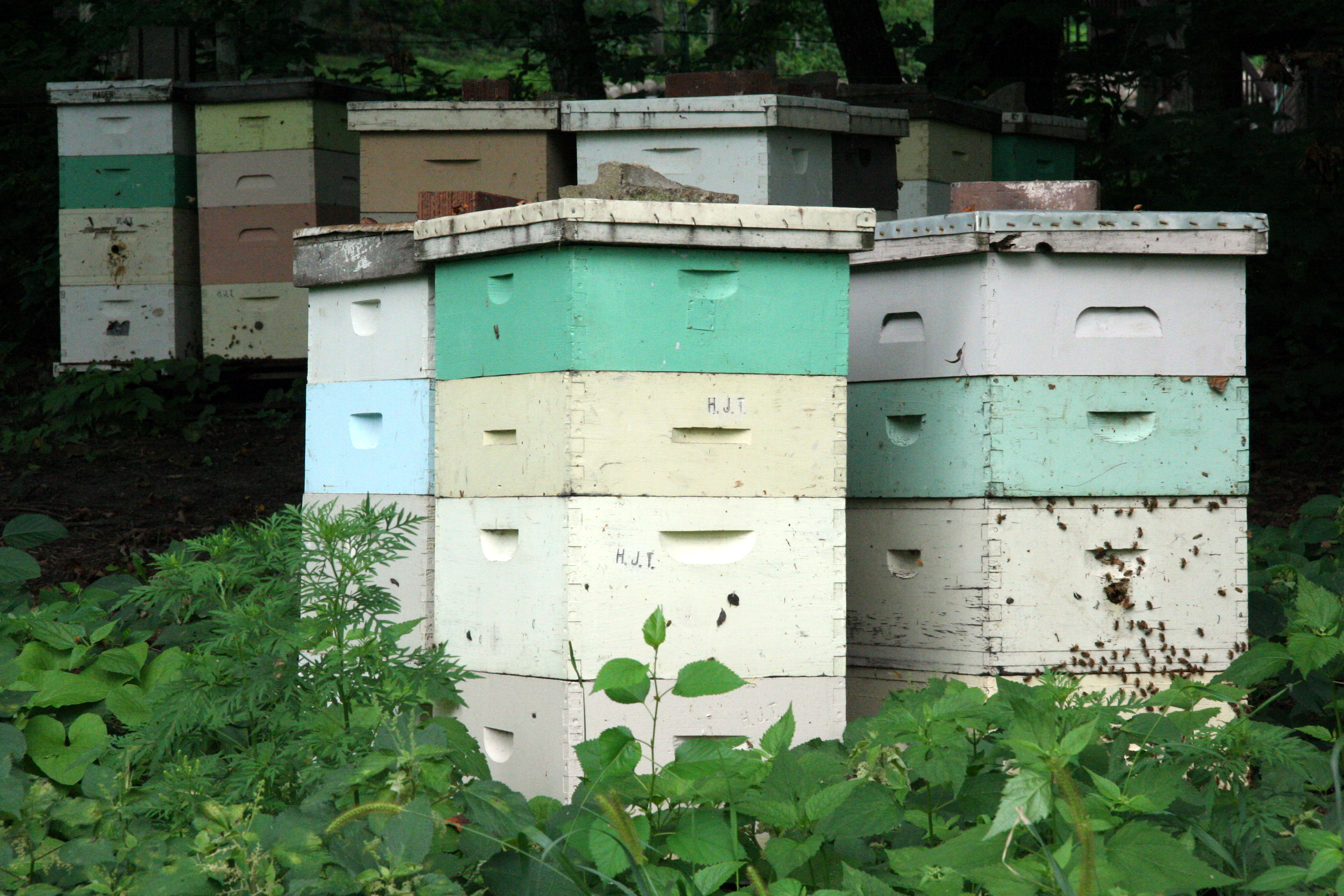|
Honey Hunting
Honey hunting or honey harvesting is the gathering of honey from wild bee colonies and is one of the most ancient human activities and is still practiced by aboriginal societies in parts of Africa, Asia, Australia and South America. Some of the earliest evidence of gathering honey from wild colonies is from rock painting, dating to around 8,000 BC. In the Middle Ages in Europe, the gathering of honey from wild or semi-wild bee colonies was carried out on a commercial scale. Gathering honey from wild bee colonies is usually done by subduing the bees with smoke and breaking open the tree or rocks where the colony is located, often resulting in the physical destruction of the colony. Africa Honey hunting in Africa is a part of the indigenous cultures in many parts and hunters have hunted for thousands of years. Asia Nepal A documentary by freelance photo journalists Diane Summers and Eric Valli on the Honey hunters of Nepal documents Gurung tribesmen of west-central Nepal ente ... [...More Info...] [...Related Items...] OR: [Wikipedia] [Google] [Baidu] |
Honey
Honey is a sweet and viscous substance made by several bees, the best-known of which are honey bees. Honey is made and stored to nourish bee colonies. Bees produce honey by gathering and then refining the sugary secretions of plants (primarily floral nectar) or the secretions of other insects, like the honeydew of aphids. This refinement takes place both within individual bees, through regurgitation and enzymatic activity, as well as during storage in the hive, through water evaporation that concentrates the honey's sugars until it is thick and viscous. Honey bees stockpile honey in the hive. Within the hive is a structure made from wax called honeycomb. The honeycomb is made up of hundreds or thousands of hexagonal cells, into which the bees regurgitate honey for storage. Other honey-producing species of bee store the substance in different structures, such as the pots made of wax and resin used by the stingless bee. Honey for human consumption is collected from wild ... [...More Info...] [...Related Items...] OR: [Wikipedia] [Google] [Baidu] |
Sunderbans
Sundarbans (pronounced ) is a mangrove area in Ganges Delta, the delta formed by the confluence of the Padma River, Padma, Brahmaputra River, Brahmaputra and Meghna Rivers in the Bay of Bengal. It spans the area from the Baleswar River in Bangladesh's division of Khulna Division, Khulna to the Hooghly River in India's state of West Bengal. It comprises closed and open mangrove forests, land used for agricultural purpose, mudflats and barren land, and is intersected by multiple tide, tidal streams and channels. Sundarbans is home to the world's largest area of mangrove forests. Four protected areas in the Sundarbans are enlisted as UNESCO World Heritage Sites, viz. Sundarbans West Wildlife Sanctuary, Sundarbans West (Bangladesh), Sundarbans South Wildlife Sanctuary, Sundarbans South (Bangladesh), Sundarbans East Wildlife Sanctuary, Sundarbans East (Bangladesh) and Sundarbans National Park (India). Despite these protections, the Indian Sundarbans were considered endangered in a 2 ... [...More Info...] [...Related Items...] OR: [Wikipedia] [Google] [Baidu] |
Nuremberg Imperial Forest
Nuremberg ( ; german: link=no, Nürnberg ; in the local East Franconian dialect: ''Nämberch'' ) is the second-largest city of the German state of Bavaria after its capital Munich, and its 518,370 (2019) inhabitants make it the 14th-largest city in Germany. On the Pegnitz River (from its confluence with the Rednitz in Fürth onwards: Regnitz, a tributary of the River Main) and the Rhine–Main–Danube Canal, it lies in the Bavarian administrative region of Middle Franconia, and is the largest city and the unofficial capital of Franconia. Nuremberg forms with the neighbouring cities of Fürth, Erlangen and Schwabach a continuous conurbation with a total population of 800,376 (2019), which is the heart of the urban area region with around 1.4 million inhabitants, while the larger Nuremberg Metropolitan Region has approximately 3.6 million inhabitants. The city lies about north of Munich. It is the largest city in the East Franconian dialect area (colloquially: "Franconian"; ... [...More Info...] [...Related Items...] OR: [Wikipedia] [Google] [Baidu] |
Fichtel Mountains
The Fichtel MountainsRandlesome, C. et al. (2011). ''Business Cultures in Europe'', 2nd ed., Routledge, Abingdon and New York, p. 52. . (german: Fichtelgebirge, cs, Smrčiny), form a small horseshoe-shaped mountain range in northeastern Bavaria, Germany. They extend from the valley of the Red Main River to the Czech border, a few foothills spilling over into the Czech Republic. They continue in a northeasterly direction as the Elster Mountains, and in a southeasterly direction as the Upper Palatine Forest. The Fichtel Mountains contain an important nature park, the Fichtel Mountain Nature Park, with an area of . Etymology The first person to write about the Fichtel Mountains, Matthias of Kemnath (actually Matthias Widmann, born 23 February 1429 in Kemnath) reported in 1476: ''Ein bergk, hoch, weitt, wolbekant ligt in Beiern, gnant der Fichtelberg'' ("A mountain, high, wide and well-known, lies in Bavaria, known as the Fichtelberg"). In descriptions of the border in 1499 and 15 ... [...More Info...] [...Related Items...] OR: [Wikipedia] [Google] [Baidu] |
Conifer
Conifers are a group of conifer cone, cone-bearing Spermatophyte, seed plants, a subset of gymnosperms. Scientifically, they make up the phylum, division Pinophyta (), also known as Coniferophyta () or Coniferae. The division contains a single extant class (biology), class, Pinopsida. All Neontology, extant conifers are perennial plant, perennial woody plants with secondary growth. The great majority are trees, though a few are shrubs. Examples include Cedrus, cedars, Pseudotsuga, Douglas-firs, Cupressaceae, cypresses, firs, junipers, Agathis, kauri, larches, pines, Tsuga, hemlocks, Sequoioideae, redwoods, spruces, and Taxaceae, yews.Campbell, Reece, "Phylum Coniferophyta". Biology. 7th. 2005. Print. P. 595 As of 1998, the division Pinophyta was estimated to contain eight families, 68 genera, and 629 living species. Although the total number of species is relatively small, conifers are ecology, ecologically important. They are the dominant plants over large areas of land, most ... [...More Info...] [...Related Items...] OR: [Wikipedia] [Google] [Baidu] |
Beehive
A beehive is an enclosed structure in which some honey bee species of the subgenus '' Apis'' live and raise their young. Though the word ''beehive'' is commonly used to describe the nest of any bee colony, scientific and professional literature distinguishes ''nest'' from ''hive''. ''Nest'' is used to discuss colonies that house themselves in natural or artificial cavities or are hanging and exposed. ''Hive'' is used to describe an artificial/man-made structure to house a honey bee nest. Several species of ''Apis'' live in colonies, but for honey production the western honey bee (''Apis mellifera'') and the eastern honey bee (''Apis cerana'') are the main species kept in hives. The nest's internal structure is a densely packed group of hexagonal prismatic cells made of beeswax, called a honeycomb. The bees use the cells to store food (honey and pollen) and to house the brood (eggs, larvae, and pupae). Beehives serve several purposes: production of honey, pollination of nearby ... [...More Info...] [...Related Items...] OR: [Wikipedia] [Google] [Baidu] |
Beekeeper
A beekeeper is a person who keeps honey bees. Beekeepers are also called honey farmers, apiarists, or less commonly, apiculturists (both from the Latin '' apis'', bee; cf. apiary). The term beekeeper refers to a person who keeps honey bees in beehives, boxes, or other receptacles. The beekeeper does not control the creatures. The beekeeper owns the hives or boxes and associated equipment. The bees are free to forage or leave (swarm) as they desire. Bees usually return to the beekeeper's hive as the hive presents a clean, dark, sheltered home. Purposes of beekeeping Value of honey bees Honey bees produce commodities such as honey, beeswax, pollen, propolis, and royal jelly. Some beekeepers also raise queens and other bees to sell to other farmers, and to satisfy scientific curiosity. Beekeepers also use honeybees to provide pollination services to fruit and vegetable growers. Many people keep bees as a hobby. Others do it for income either as a sideline to other work or as a ... [...More Info...] [...Related Items...] OR: [Wikipedia] [Google] [Baidu] |
Early Middle Ages
The Early Middle Ages (or early medieval period), sometimes controversially referred to as the Dark Ages, is typically regarded by historians as lasting from the late 5th or early 6th century to the 10th century. They marked the start of the Middle Ages of European history, following the decline of the Western Roman Empire, and preceding the High Middle Ages ( 11th to 13th centuries). The alternative term ''late antiquity'', for the early part of the period, emphasizes elements of continuity with the Roman Empire, while ''Early Middle Ages'' is used to emphasize developments characteristic of the earlier medieval period. The period saw a continuation of trends evident since late classical antiquity, including population decline, especially in urban centres, a decline of trade, a small rise in average temperatures in the North Atlantic region and increased migration. In the 19th century the Early Middle Ages were often labelled the ''Dark Ages'', a characterization based on t ... [...More Info...] [...Related Items...] OR: [Wikipedia] [Google] [Baidu] |
Stone Age
The Stone Age was a broad prehistoric period during which stone was widely used to make tools with an edge, a point, or a percussion surface. The period lasted for roughly 3.4 million years, and ended between 4,000 BC and 2,000 BC, with the advent of metalworking. Though some simple metalworking of malleable metals, particularly the use of gold and copper for purposes of ornamentation, was known in the Stone Age, it is the melting and smelting of copper that marks the end of the Stone Age. In Western Asia, this occurred by about 3,000 BC, when bronze became widespread. The term Bronze Age is used to describe the period that followed the Stone Age, as well as to describe cultures that had developed techniques and technologies for working copper alloys (bronze: originally copper and arsenic, later copper and tin) into tools, supplanting stone in many uses. Stone Age artifacts that have been discovered include tools used by modern humans, by their predecessor species in the ... [...More Info...] [...Related Items...] OR: [Wikipedia] [Google] [Baidu] |
Zeidler Historische Darstellung Puppe
Zeidler is a German occupational surname meaning "Beekeeper". Notable people with the surname include: * Alfred Zeidler (born 1909), German SS concentration camp commandant *Carl Zeidler (1908–1942), American mayor * David Zeidler (1918–1998), Australian chemist and industrialist * Eberhard Heinrich Zeidler (1926–2022), German-Canadian architect * Eberhard Hermann Erich Zeidler (1940–2016), German mathematician *Frank Zeidler (1912–2006), American politician *Judith Zeidler (born 1968), German rower *Othmar Zeidler (1850–1911), Austrian chemist * Peter Zeidler (born 1962), German football manager *Susanna Elizabeth Zeidler Susanna Elizabeth Zeidler (1657 – c. 1706) was a German poet. In 1686 Zeidler published ''Jungferlicher Zeitvertreiber'' (Pastime for Virgins), a collection of poems. Along with other German women writers of Baroque style like Anna Ovena Hoye ... (1657–c. 1706), German poet * Wolfgang Zeidler (1924–1987), German legal scholar and judge {{sur ... [...More Info...] [...Related Items...] OR: [Wikipedia] [Google] [Baidu] |
Riau Province
Riau is a province of Indonesia. It is located on the central eastern coast of Sumatra along the Strait of Malacca. The province shares land borders with North Sumatra to the northwest, West Sumatra to the west, and Jambi to the south. According to the 2020 census, Riau had a population of 6,394,087 across a land area of 87,023.66 square kilometres;Badan Pusat Statistik, Jakarta, 2021. the official estimate as at mid 2021 was 6,493,603. The province comprises ten regencies and two cities, with Pekanbaru serving as the capital and largest city. Historically, Riau has been a part of various monarchies before the arrival of European colonial powers. Muara Takus temple in Kampar Regency, believed to be a remnant of the Buddhist empire of Srivijaya circa 11th-12th century. Following the spread of Islam in the 14th century, the region was then under control of Malay sultanates of Siak Sri Indrapura, Indragiri, and Johor. The sultanates later became protectorate of the Dutch and we ... [...More Info...] [...Related Items...] OR: [Wikipedia] [Google] [Baidu] |








